Have you ever been to a store or website and noticed an image of random black and white dots in a square? The words “Scan me” may be printed somewhere nearby.
If so, then you’ve laid eyes on one of the millions of QR codes used by businesses.
A QR code, short for “Quick Response Code,” is an advanced type of scannable barcode, developed specifically to offer a more sophisticated solution than standard barcodes.
QR codes can hold much more data than barcodes. And QR codes have a much more rapid response time too. When scanned with a QR code reader, the QR code is decoded and its content made accessible to the viewer in an instant. That explains how QR codes got their name.
But there’s much more to it than that. QR codes are a powerful tool for businesses, colleges, and other organizations, and they’re increasing in popularity and use all over the world — not just in the U.S., but in Asia, Africa, and the Middle East too.
There’s one major reason for the QR code’s popularity: Anyone with a smartphone can read a QR code. Given that nearly half the world’s population uses smartphones, any business that wants to communicate directly with customers can and should use QR codes.
In this comprehensive guide, we’ll get down to the nitty-gritty of QR codes for business, including how and why they were developed, what makes them so effective, and how to generate successful QR codes. Here are the QR code topics you’ll learn about:
- How QR codes work
- The history of QR codes
- The difference between barcodes and QR codes
- How businesses are using QR codes, including restaurants, colleges, retailers, marketers, and more
- Different types of QR codes, even unexpected ones like email, text, and phone calls
- How to create a QR code, step by step
- How to track QR codes to get the best performance
- The difference between static and dynamic QR codes
- The QR code metrics you should be tracking
- How to choose QR code tracking software
- How to use QR codes to collect payments — contactless-ly!
Want to get your business started with QR codes? Dive into the guide.
How QR codes work — plus a brief history
If you’re familiar with the barcode concept, then understanding QR codes is easy.
So how does a QR code work?
A QR code is an image made up of black dots and shapes that contain unique data. When scanned with a QR code reader, the image is decoded and read.
QR codes can contain various types of data, including numbers, letters, and binary data.
To read a QR code, you need QR code reader software, which is built into most newer smartphones. Just scan the QR code with your mobile device, and the data is instantly viewable on your phone screen.
The main advantage of QR codes is how accessible they are. You don’t need special equipment or expertise to read a QR code. All you need is a smartphone.
QR code vs barcode: What’s the difference?
When you shop in a supermarket, the cashier scans each item’s barcode. This identifies the product and price in the store’s data system. Every ping is the sound of another barcode being read.
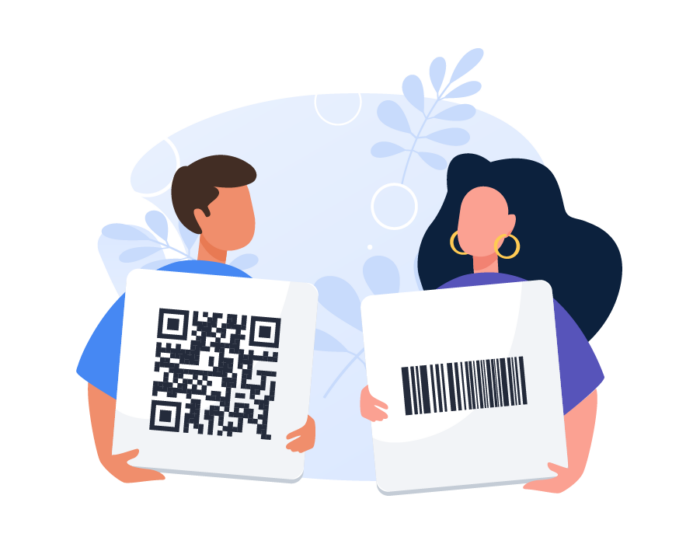
Similarly, when you hold your mobile device over a QR code and scan it, the information in the code is pinged to your phone.
Both QR codes and barcodes are images encoded with data and scanned by a device (i.e., the grocery checkout scanner or your smartphone) that reads the data and translates it for the user.
Here’s where the differences between QR codes and barcodes lie:
1D vs 2D
Barcodes consist of a single strip of horizontal lines, or bars, while QR codes are made up of a horizontal and vertical grid formation. Barcodes are essentially a one-dimensional code, while QR codes belong to the next-generation 2D barcode family. This has an impact on the kind of data that each type of code can hold.
Data capabilities
Barcodes hold less than 100 characters, so they’re too simple to be individualized. Retail barcodes contain basic data, such as product price and SKU. There’s one barcode for each product type, rather than specific barcodes for individual items.
Due to their grid-like formation, QR codes support far more robust data capabilities. They can be individualized for different items within a product category. QR codes can hold much more data too, up to 3 KB.
Ease of scanning
Have you ever tried to scan a scratched barcode? It won’t work. QR codes, on the other hand, are more resilient to mild damage, which makes them more reliable.
Plus, anyone with a smartphone can read a QR code. To read a barcode, you typically need a special barcode scanner, and those are only found in factories, stores, or point-of-sale machines.
From past to present: The history of the QR code
The story of the QR code began in the early 1990s in Japan at Denso Wave, a car component manufacturer and subsidiary of Toyota.
Masahiro Hara, a company engineer, was called in to tackle a problem. Barcodes weren’t able to pack in enough data to keep up with the needs of car manufacturers. So he brought together a team and started looking for a solution.
From 1 to 2D
Initially, Hara’s team got inspiration from 2D barcodes already developed in the U.S.
The 2D barcodes use both vertical and horizontal axes, while regular barcodes are just a 1D horizontal line. The team began researching how to create an original 2D barcode that could contain much more data. Their work resulted in the development of the new square-shaped QR code that could handle up to 7,000 data characters.
The next obstacle
However, their success led to a new problem. When Hara tried scanning the QR code, the surrounding text on the page interfered with the scanner’s ability to differentiate the code as a separate entity. The QR code wasn’t readable, so they went back to the drawing board.
Hara’s team set about devising a mark that was the ideal ratio of black to white to help the scanner identify the boundaries of the QR code. This square mark was embedded at the corners of the QR code, and it worked! The scanner read the QR code successfully.

QR code to market
In 1994, the QR code officially launched. Its ability to scan a large amount of data incredibly quickly gave it the name “Quick Response Code.”
Japanese car manufacturers were eager to adopt QR codes. Their complex production processes involved multiple components, and QR codes offered a more efficient way to scan these components.
Over the years, the use of QR codes spread around the world and across industries.
With the new ability to scan QR codes via smartphones, QR codes started to become popular among consumers too. People could scan QR codes in a shop, on the internet, on a poster, or just about anywhere to get the information they needed on their phones in an instant.
Today, you can’t visit a mall or read a magazine without coming across a QR code or two.
QR code usage today: What’s the story?
Although QR codes were invented in the mid-1990s, they weren’t used widely until around 2011, when smartphones became more sophisticated and internet connections got faster.
The upward trajectory of QR codes is clear if you look at downloads of QR code sales coupons. In 2017, 1.7 billion coupons were obtained from QR codes. By 2022, that number is expected to jump to 5.3 billion.
Southeast Asia and India are hotspots for QR code use. In China, 50 percent of the population scans QR codes several times a week. In 2016, the Indian government initiated a move toward a cashless society, which sent the use of digital payments soaring. Guess what? QR codes are a great way to facilitate them. The popular payment app, Paytm, which uses QR codes, is supported by 9 million merchants in India.
And how about the U.S.? Some of the biggest American brands use QR codes, including Apple, PayPal, and Nike.
In 2018, the number of Americans who scanned QR codes doubled compared to 2015.
One thing’s for certain. QR codes aren’t a passing tech fad. They are a cost-efficient and versatile tool for brands and businesses, and consumers worldwide have embraced them.
Brands successfully using QR codes
In 2020, the word “contactless” took on a whole new meaning.
Minimizing physical contact with customers is no longer just a matter of convenience. It’s also about health and safety.
At the same time, business owners need to build strong relationships with their customer base, and that’s even harder to do in a contactless environment.
If your business needs to collect customer data or conduct other interactions with customers while reducing contact, QR codes are a great solution.
With QR codes, businesses can link to all kinds of forms for customer data collection. The customer simply scans the QR code with their smartphone, and the digital form automatically opens for them to complete on their device. This eliminates the need for hard copies or email conversations.
Businesses can display QR codes in their stores or offices, or on their websites, or they can send QR codes to customers via email or SMS. No matter how a QR code is displayed, the customer simply needs to scan it. Then, the form — whether it be a registration form, waiver form, order form, or any other kind of form — is available immediately, right in the palm of their hands. This is a powerful tool for businesses in all industries.
Let’s take a look at some QR code examples and how brands are using them to succeed.
Can I take your order? How restaurants use QR codes
There are many customer touchpoints in restaurant and takeout orders. The customer has to see a menu, choose their meal, provide delivery details, pay for the meal, and receive their order.
A QR code can make the whole ordering process contactless and simple. Forget the old days of phoning a restaurant to place an order. Now, restaurant owners can create a digital order form and link it to a QR code menu. When the customer scans the QR code, the online order page instantly appears on their device.
For example, McDonald’s in the Philippines uses QR codes for drive-thru orders and pickups. Customers scan the QR code to instantly access the drive-thru menu and place their order. This makes it so much easier for customers to order on the go, plus it’s quicker for staff to handle and clear the order.

You can even use QR codes for in-house dining. Rather than placing an order with the wait staff, the customer can scan a QR code and order on their mobile phone while seated at the restaurant table. This is particularly important during COVID-19 when strict government regulations are changing the way people are dining out (and in).
QR codes in the classroom: Education made easy
In schools and colleges, there’s a lot of interaction between students, teaching staff, and administrative staff, both in and out of the classroom.
Applications and admissions processes are inevitably awash with forms and information. A lot of student data must be gathered and stored. Not to mention the teaching and learning experience itself, from curriculum distribution, online tutorial links, essay submissions, interactive project signups, and much more.
Many students today have smartphones. With the help of QR codes, students can access a wide range of education forms in real time. This extends to in-class assignments too. Rather than handing out printed papers, emailing student lists, or directing study groups to certain web pages, instructors can use QR codes to connect with students in a more direct and instant way.
Here’s an example of a college poster featuring a handy QR code. College applicants attending admissions day can have all the information they need at their fingertips, including something as simple and vital as a digital map showing them where they need to go.
Find out more about them in our guide, how to use QR codes in the classroom.
May I help you? QR codes in retail businesses
The shopping experience today looks completely different than it did just a few years ago. The main shift has been toward a seamless “omnichannel” customer journey.
What does that mean in practice? The customer doesn’t just enter a store, browse, and buy anymore. Now, they research online, compare prices on their mobile phones, order online, pick up in-store, download digital coupons, and every imaginable combination of these actions.
Retailers are continually looking for ways to make the buying experience smoother and easier. For example, by digitizing a range of retail order forms, stores can give their customers a quick link via QR code to provide their order information, including detailed and sensitive data such as the delivery address and payment information.
Particularly in the era of COVID-19, retail brands need to be flexible and offer contactless shopping to compete. In March 2020, there was a 443 percent increase in “click & collect” purchases in the U.S. and Canada, and a 96 percent week-on-week increase in the number of retailers that provided this service to their customers.
The British supermarket chain Asda is doing just that with their Click & Collect lockers. Customers purchase their groceries online and receive a QR code with the digital receipt. The customer scans the QR code at the locker to release the order. From digital to physical, the QR code is a simple way to connect the customer with the shopping experience — no contact required.
For more information on retail QR codes.
QR codes in marketing: Connect with potential customers
A huge challenge for marketers is how to collect customer signup information. In a digital world, an old-fashioned phone call and appointment book isn’t going to be fast enough. That’s where QR codes linked to signup forms come in handy.
Imagine you’re hosting a booth at a bridal show, promoting wedding photography services. You’ve got a special offer up your sleeve to attract new customers — a free half-hour engagement shoot for every couple that books the wedding service.
Now, imagine your customers can book the free shoot instantly via a QR code that links to a digital scheduling calendar, all while standing at your booth and hearing your marketing pitch! No fussing, waiting, or extra time for them to second-guess their decision.
Collecting email addresses at events is another sticky issue for marketers. No customer wants to juggle a champagne glass in one hand while fumbling to write down their email address with the other. A QR code linked to a digital signup form can go a long way in collecting accurate email addresses and building a distribution list.
QR code types
What makes QR codes such a great tool for business? The combination of quick scannability and much larger data capacity than other types of barcodes.
While regular barcodes can hold a maximum of 100 characters, QR codes can handle 7,000! This leaves the door wide open to create a vast range of QR codes with different content for every need.

Video, email, text message, even phone calls — here’s an overview of the QR code types that are most popular and effective, and how businesses can use them to boost performance and build customer relationships.
QR codes for video
People love to watch videos, period.
By 2021, people will spend an average of 100 minutes a day watching videos. And marketers know it. That’s why 95 percent said they would hold steady, if not increase, their video marketing spend in the next year.
With so much video content out there, making sure your video is seen is one of the toughest challenges. QR codes, however, can make a big difference.
Connecting a video to a QR code is easy. Simply generate a QR code and link it to an online video, either a URL or a video file. When the QR code is scanned, it will lead the viewer directly to the video content.
Video channels such as YouTube and Vimeo support QR codes, but you can upload a video that’s hosted anywhere to a QR code. All you need is a video URL.
If you’re uploading a video file to a QR code, make sure it’s an MP4, as this format is most widely compatible with Android and iOS.
Video QR codes are a great way to bridge the gap between offline and online experiences. For example, you can display a video QR code on a product flyer that links to a video demo of the product. Or you can link a video message from the CEO to a QR code printed on posters at a company event.
However you choose to use video in your business, you can use video QR codes to get your videos seen.
QR codes for email
Email never gets old. As one of the earliest digital technologies, it’s become a staple of daily life. Businesses continue to get great returns from email — an average of $42 for every $1 spent on email marketing — and with the help of QR codes, email can be an even more versatile tool.
QR codes can help with two major tasks in email marketing: building email lists and engaging customers with great content.
Building an email list with QR codes is very simple to do and doesn’t require much investment. First, create an online email registration form, then link the form URL to a QR code. Next, display the QR code anywhere you come in contact with customers — in a store, on web pages, on flyers and other printed marketing materials, or even at the end of a marketing video. When the customer scans the email QR code, the signup form will instantly appear on their mobile device.
You can also use QR codes to make marketing emails more interactive and interesting. An email promoting a special discount offer can include a QR code that links to the coupon.
You can insert multiple QR codes in an email promoting a series of products. The QR code can link to product videos, product web pages, or customer testimonials — any content that will help engage the customer is great to include in marketing emails and can be easily linked to a QR code.
QR codes for text messaging
Text messages get incredible open rates — we’re talking as high as 98 percent. Combine a text message with a QR code that links to quality content, and marketers have a powerful tool to connect with customers.
Here’s how to link QR codes to text messages. Generate the QR code, and enter the text message you want to send, including any URLs and a CTA, and you’re set.
Display the QR code wherever your customers might see it. When they scan the code, the text message will be sent straight to their mobile phone. For example, you can display a QR code on a product web page or flyer. Customers who want to learn more about the product will scan the code and receive information about it via SMS.
These QR codes can also make it easier for customers to contact you. Just create a QR code that sends an automated SMS to your company on behalf of the client.
For instance, if a client is interested in scheduling a product demo, they can scan the QR code. The code will then send an SMS to a predefined company phone number on the customer’s behalf, with an automated message, such as “Hi, I’d love to schedule a demo. Please get back to me.”
This kind of QR code takes all the work out of contacting you; the customer just needs to scan it.
PDF QR codes
We haven’t quite arrived at a paperless world, but we’re getting closer. Businesses save a lot of resources by going digital with many of their marketing and customer materials. The hard part is getting those PDF files — such as brochures, catalogs, invitations, and menus — into the hands of customers.
Sending PDF attachments by email is difficult, and PDF downloads from websites aren’t a very personal way of interacting with customers.
QR codes are an increasingly popular way to share PDF files. All you have to do is link the PDF document to the QR code. Then, anyone can view the PDF by scanning the QR code.
This is a good way for restaurants to support online ordering, for example. A PDF QR code on the printed menu directs customers to the online menu and order form instantly, so they don’t need to type in the URL or search for the restaurant’s website.
It’s also a convenient way for retailers to provide customers with take-home product catalogs, eliminating printing costs (and saving trees).
Phone call QR codes
One of the more novel ways that companies can use QR codes is by linking them to a phone number. When a person scans the QR code, the mobile device automatically sets up a call to the designated number.
This is one of the easiest ways to give customers your phone number. They can either call right away or save it to their address book for future reference.
QR codes that initiate phone calls are typically displayed on posters, flyers, and web pages. They can also appear on product packaging or business cards.
By the time a customer is ready to call your business, they’re already interested. This is a prime moment to give them what they need to make contact and set a relationship in motion. These QR codes might be one of the easiest ways to do that, in almost any setting.
Create a QR code that works for you
QR codes have loads of benefits, but there’s one that stands above all — they are incredibly easy to create.
This is no exaggeration. With the right tool, generating a QR code involves little more than a few clicks. Creating the QR code is the simplest part. A QR code generator will do it for you. As a business owner, you should focus on what content the QR code will link to. This is what makes the difference between an average QR code and a successful one.
Linking QR codes to forms is one of the ways you can reduce friction and speed up your customer interactions. When exploring how to create a QR code that can benefit your business, consider transforming your customer forms to a digital QR code format. With just a few minutes of extra effort, you’ll streamline customer communications and facilitate contactless processes, such as registrations, waivers, approvals, and many other standard customer forms.
How to make a QR code: Step by step
In just four steps, you can generate a QR code-linked form that will boost your business:

1. Choose a QR code generator
QR code generator software is readily available online, and there are many free options. Businesses that use QR codes regularly should invest in a paid premium program that provides extra features, such as customized design, tracking, and dynamic QR coding.
Here are a few QR code generators you might try:
Jotform
If you want to generate QR codes for your business forms, Jotform offers a free QR code generator as part of its Form Builder. Just one extra click, and you can instantly create and share a QR code for any form, directly within Jotform.
QR Code Generator
This full-service QR code generator system is a great place to start exploring and work your way up to advanced, customized QR codes. Start with a 14-day free trial.
QR Code Monkey
The free option provides all the basics for QR code creation. Plus, the QR Code Studio provides all the advanced features a business needs.
2. Create the content to link to the QR code
Now it’s time to create the content the user will receive when they scan the QR code. If you’re generating a QR code for a business card, you may want to link to the company website. Or perhaps you prefer to link to a landing page where the customer can register their email address to receive company updates.
The type of content you link to will depend on the purpose of the QR code. If you’re linking to a restaurant menu, you should create an online order form with payment checkout. The options are endless — it all boils down to your business needs and goals.
3. Select the data fields for the digital form
When linking to a digital form, include the relevant data fields you want customers to complete. For example, if the form is to register for an email newsletter, the person’s name and email address may be enough. If they’re signing up for a customer support request, then a lot more detail will be needed.
Make sure your QR-coded forms are thorough and professional by using a fully customizable form builder. This allows you to create forms based on templates and then customize them to match your branding. Form builders also provide data-collection functions so you can get the most from your form data.
4. Customize the QR code
If you thought QR codes were just a boring jumble of black and white dots and shapes, you’re wrong. QR codes today can have all sorts of colors, gradients, and other customized design features to make them stand out and match your business’s brand. Here are four aspects to consider for your QR code design.
Color
The dots and shapes that make up the QR code pattern can be altered to a different color or several colors, and can feature gradients that are much more visually exciting. Consider where your QR code will appear, and make sure you choose a color scheme that suits the surrounding design.
Size
QR codes must be a minimum of 2 cm by 2 cm to scan properly. However, the right proportion will depend on where the QR code will appear. If featured on a poster, it will naturally need to be larger. If on a hand-held flyer or table stand, then a smaller QR code will suffice.
Logo
Adding a logo to the QR code gives instant visual recognition, and turns a generic code into a branded experience. With a customizable QR code generator tool, you can easily add your logo to any QR code. Make sure it’s properly proportioned so it’s noticeable without disturbing the functionality of the QR code.
Position markers
The markers positioned at the corners of a QR code are necessary. They demarcate the QR code from surrounding elements and make the code readable to the scanning software. That doesn’t mean they have to be boring, though. In the above example, Starbucks rounded the markers slightly and changed them to the brand’s unique green tone.
Before releasing a QR code
Testing before the release date is a smart business practice for any type of project or deliverable. The same goes for QR codes.
Before printing posters with a QR code, or sending out a promotional email with a QR code inside, make sure you conduct QR code testing for various functions and parameters so you can be sure the code is working and effective.
Test every QR code before you release it. Here are four things to incorporate into your QR code test.
Lighting
Test the QR code in different lighting situations — indoors, outdoors, direct sun, dim lighting, or any other lighting situation where customers will scan your QR code.
Distance
A distance test will help you determine if you got the QR code proportions right. Try scanning the QR code from different distances you expect your customers to use. Does the size let you scan comfortably? If not, make the necessary adjustments.
Devices
Test the QR code on several different devices, including an Apple and an Android device. You should also test it with several popular QR reader tools to make sure it works on all of them.
Links
Pay attention to the content linked to the QR code. Is it linked correctly? Does the content look good? Are your linked forms functioning as they should? Without the right link and content, the QR code won’t perform, so make sure your QR code content is correct and functioning.
QR code tracking: Make every code count
A business doesn’t exist in a vacuum. Every activity has an impact, and you want that impact to be positive.
The only way to know whether your processes are paying off is by tracking their performance. This also applies to QR codes.
You can track and monitor QR codes on several parameters, such as how many times the QR code was scanned, when and where the most scans were made, and what devices were used most often to scan the code.
Often, QR code tracking can provide insights into larger business activities or goals. For example, you can assign QR codes to different marketing campaigns to help gain exposure among the target audience. Then you can track the performance of QR codes according to each specific campaign.
QR code tracking provides valuable data about the behavior and engagement of customers and audiences. But there’s one condition. If you want to track your QR codes, they must be dynamic, rather than static.
Static vs dynamic QR codes: What’s the difference?
A static QR code is a “closed” code based on fixed data that cannot be changed or edited. This also means it cannot be tracked. Static QR codes are best for campaigns that don’t need to be monitored and optimized over time, such as one-off events.
Dynamic QR codes, on the other hand, can be altered even after they have been generated. This is great for more complex business activities and campaigns, such as recurring promotions. For example, if a company uses a QR code for a monthly campaign, they can simply edit the data contained in the QR code every month. The QR code image remains the same, but it now links to new, updated promotional information.
With dynamic QR codes, it’s also possible to change the type of code after it has already been generated. For instance, a video QR code can be changed to a PDF QR code, and so on.
Dynamic QR codes offer much more than flexibility — they’re also trackable. With dynamic QR codes, you can continually gather data about how the code is performing, so you can maximize its effectiveness according to your business needs.
QR code tracking metrics: What not to miss
The data you get from QR code tracking is pretty straightforward, and it can also be very powerful in helping you understand your customers and campaigns. Here are the main metrics you should track for QR codes.
Number of scans
This is a measure of how many scans the QR code has registered. The number will hopefully increase over time. A low metric lets you know that the QR code isn’t engaging and possibly isn’t in the ideal location.
Unique scans
This shows you how many new customers scan the QR code in a given time frame. It doesn’t include multiple scans by the same device. This makes it a more accurate indicator of how many individual customers are scanning the QR code than the total number of scans.
Location
As the saying goes, location is everything. A QR code will perform best if it’s exposed to the right audience in the right place. Knowing where the QR code is getting high scan rates is important data as this shows you where your most interested customers are.
Date and time
Track the days and times when the QR code is scanned. Discover whether the QR code is getting engagement during the morning versus evening, weekdays versus weekends, and more. This is an important insight into the behavior of your target audience.
Device and operating system
See which devices your audience is using to scan the QR code, whether it be Apple, Android, or tablet.
You can also find out which browser is most popular among those who scanned the code. Was it Mobile Chrome, Safari Mobile, or something else? This can make a difference to the type of content you link the QR code to and give you insights into the habits and personalities of the audience.
QR code tracking software: The must-haves
Sixty percent of marketers are under pressure to prove the ROI of their marketing activities. If you’re feeling that pressure, start tracking QR code data.
Sooner or later, businesses that regularly use QR codes will need to implement QR code tracking software to understand how their QR codes are performing. Here are three things to look for when choosing tracking software for QR codes.
Ease of use
As with any software product, invest in the one that pairs maximum functionality with the best user experience. Keep it simple and effective. There are lots of software options available, from the more basic setups to sophisticated packages that offer full management of QR code inventory.
Cost
There are tons of free QR code tracking apps; however, they may not offer the right functionality. When a business is serious about using QR codes, it’s probably best to turn to a paid software solution. Choose the QR code tracking system that best supports your business without extra features that cost more yet don’t contribute to your needs.
Extra functions
Want to get the most from QR codes? You need more than tracking.
Testing the performance of QR codes is also key. It enables you to determine which QR codes are working best and why. Then you can optimize your QR codes to get even better results.
When searching for QR code tracking software, go for one that offers A/B testing functions and customized reporting so you can optimize your QR codes for any business goal.
Collecting payments with QR codes — go contactless
The way people shop has shifted dramatically in the past decade, and that change is accelerating.
E-commerce is through the roof, and hybrid online-offline shopping is taking over a big chunk of retail spending. Businesses must make it as easy as possible for customers to close the deal and pay for their purchases in a new digitized reality. This is fueling the rise of “contactless payments,” and it’s much more than a buzzword. According to Mastercard, over half of Americans are already using contactless payment.

The idea behind contactless payments isn’t new. The ancient and traditional payment method — cash — was superseded by credit card payments decades ago. People discovered that a quick swipe and signature was a convenient substitute for notes and coins. Today, however, technology supports a much more advanced version of contactless payment. Even swiping a credit card is no longer necessary.
Digital wallets and tap-to-pay credit cards are just two examples of how businesses can facilitate contactless payments. And another? QR codes.
QR code payment: How it works
Online payment processing is becoming the new norm for businesses. Fortunately, it isn’t difficult or expensive for companies to set up online payment infrastructure. There are tons of digital payment processors available. It’s just a matter of choosing the solution that best meets the needs of the business and its customers.
Once the online payment infrastructure is in place, the trick is making it accessible to customers. How can businesses help customers reach their payment forms quickly and easily, even at the point of sale? With QR codes.
A QR code payment can easily be generated and linked to a product, invoice, or web store page. The customer scans the QR code with their mobile device, and the payment form appears on their screen instantly.
Here’s a brief step-by-step plan of how to set up QR code payment.
1. Set up a payment processor
To use QR code payments, you must be able to accept online payments via a payment processing tool like PayPal, Square, or Stripe.
2. Create a payment form
The QR code will link to an order or payment form, so you need to create professional-looking forms. This is easy to do with customizable payment form templates.
3. Generate a QR code
Create a QR code with the help of QR code generator software.
4. Link the QR code to the payment form
Connect the payment form to the QR code. When using Jotform’s Form Builder, you can do this directly without the need for an outside QR code generator.
5. Display the QR code
Display the QR code in strategic places, where your customers are likely to purchase. The payment form will open automatically on a customer’s smartphone as soon as they scan the QR code.
Creating QR code payments is quick and easy, and there are many ways that businesses can use them. Every business must take into account their customers’ payment behaviors and their sales goals to figure out the method that works for them.
How merchants use QR codes to accept payments
Nearly 40 percent of merchants worldwide already support mobile payments at the point of sale. Why not make it even easier by using QR codes for contactless payments?
Point of sale
It may seem surprising, but one of the most common places businesses use QR codes to collect payments is right next to the cash register! QR code payments transform a regular transaction into a contactless one. This is especially important when social distancing is the norm.
QR codes can be used in-store at the checkout counter with the help of a smart point-of-sale terminal. The code can either be displayed on a screen or printed out, and the customer scans it with their smartphone. Then, the customer pays directly from their phone, using the linked payment form.
A big advantage of this method is that it enables customers to pay with a digital wallet, such as PayPal or Alipay. For many customers today, this is an attractive option, preferable to paying with a credit card or cash.
Printed materials
QR code payments can be printed just like other hard copy material. Product labels, posters, catalogs — all are ideal places to display QR codes that link to a payment form. Once the payment is complete, the customer receives a confirmation and instructions about how to collect their purchase.
Another place where QR codes are often printed is on invoices. For example, many utility companies provide QR codes on printed bills, so the customer can scan and pay online. This simplifies the payment process. Instead of having to go to the company website, find the payment page, and enter the invoice details and payment information, the QR code links directly to the payment form with all relevant data already populated.
Apps and websites
QR codes on web pages can also facilitate payment. For example, a business promoting an app can feature a QR code on their web page that links to the installation and payment. Or a web-based product catalog can display a payment QR code next to each product, making it much easier for customers to scan and pay immediately.
QR codes can also facilitate app-to-app payments. In this instance, the company rep creates an order on the business’s app and generates a unique QR code for the customer. The customer scans the QR code from the business’s app and completes the payment on their phone.
In a world where 3.5 billion people are using smartphones, and shopping is a mishmash of online and offline experiences, every business can find a way to benefit from QR code payments.
Conclusion
As the saying goes, “necessity is the mother of invention.”
Nearly 30 years ago, a group of Japanese engineers saw a problem. The standard barcode just wasn’t doing a good enough job. So they put their heads together, and the QR code was born.
Fast forward to today, and the digital era is well underway. The world stands at the cusp of a new era — contactless interactions.
Businesses are searching for ways to transform their processes to be as smooth and seamless as possible. Particularly when it comes to payments, making things easy and instant for customers is the name of the game.
The QR code has come to the rescue.
At the time of its invention, the QR code was meant to track large numbers of manufacturing components.
Today, QR codes are everywhere, from posters to web pages, apps, invoices, menus, catalogs, magazine pages, and even store windows. With just a smartphone, customers worldwide can instantly access business information, order forms, payment forms, app downloads, e-stores, automated text messaging and phone calls, and much more.
All this is possible because of a simple jumble of black and white dots and shapes in a demarcated square, displayed anywhere that businesses interact with customers.
With the help of the QR code, any business can move toward contactless customer interactions. These next-generation barcodes take the act of scanning to the next level.


























































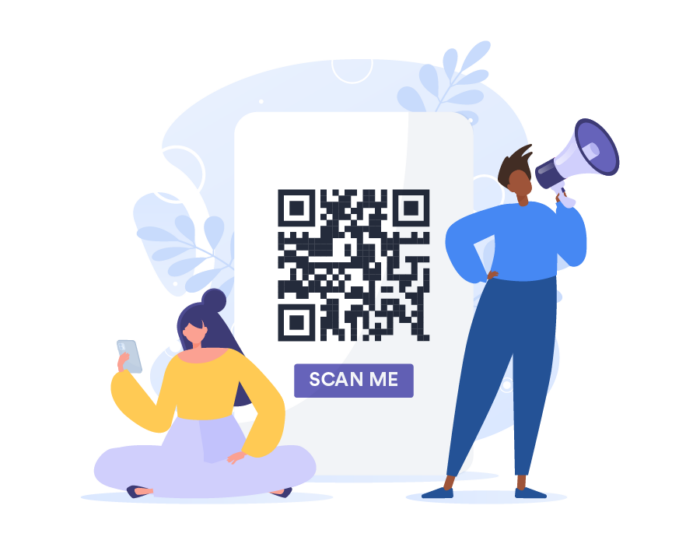





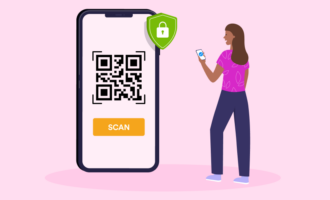






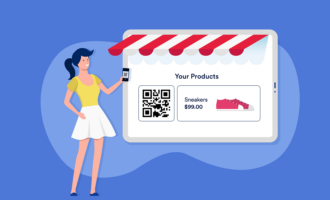






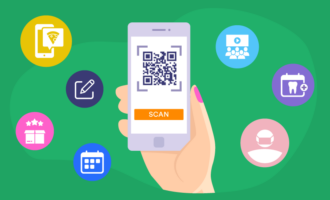


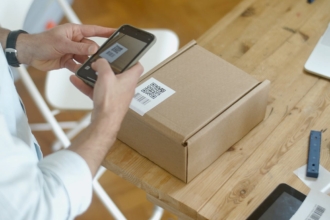

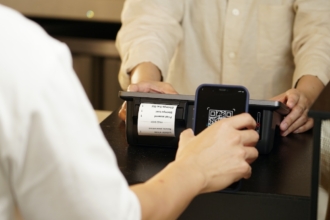






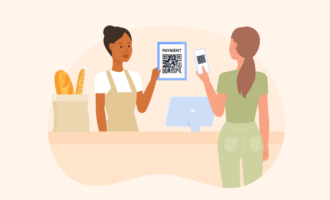





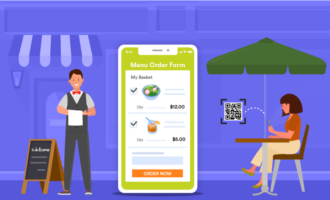
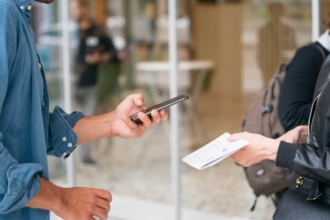

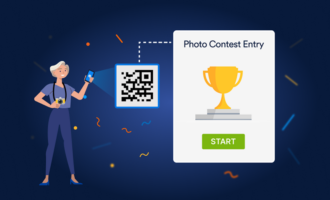

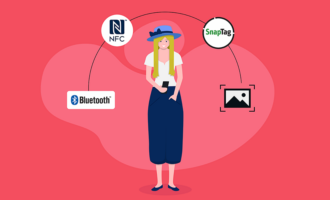




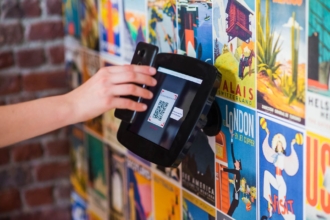


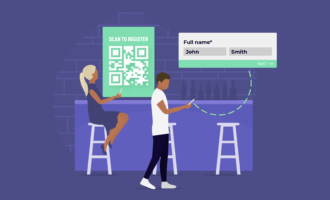
Send Comment:
3 Comments:
More than a year ago
Thank you so much for sharing such great content, it really helpful for many
I would like to add one more QR code generator here that I personally use its name
"Dynamic QR Code Generator" developed by Elsner. they provide Dynamic QR codes free of cost. this tool is best in class with all modern features.
More than a year ago
I am using qrcodechimp.com to create star-shaped QR codes and link to jotform for rating, and getting awesome results!
More than a year ago
Thanks for a very clear-headed discussion of QR codes. Frankly, I’ve always wondered what the big deal is. I didn’t realize how many ways QR codes can fit into my business activities. I saw my competitors using them and never really understood why. Now I get it. It’s interesting to see how the barcode has evolved. Not just technically but in the way that they are used with customers, and for much more than keeping track of stock. I think I’ll give it a try for my next sales campaign.